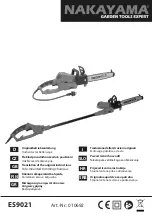
28 | GB
7. Before starting the equipment
• The equipment must be set up where it can stand
securely, i.e. it should be bolted to a workbench, a
universal base frame or similar.
• All covers and safety devices have to be properly
fitted before the equipment is switched on.
• It must be possible for the blade to run freely.
• When working with wood that has been processed
before, watch out for foreign bodies such as nails
or screws, etc.
• Before you press the ON/OFF switch check that
the saw blade is fitted correctly. Moving parts must
run smoothly.
• Before you connect the equipment to the power
supply make sure the data on the rating plate are
identical to the mains data.
8. Attachment and operation
8.1 Attaching the saw (Fig. 1, 2/6a-c)
• To adjust the turntable (16) turn the locking handle
(13) counterclockwise to release the lock.
• Slide the locking position lever (12) upwards. To do
this, take your index finger.
• Now adjust the turntable (16) and pointer (14) by
useing the required angle of the scale (15). Fix it by
turning the locking handle (13) clockwise.
• Pressing the machine head (5) lightly downwards
and removing the locking bolt (24) from the motor
bracket at the same time disengages the saw from
the lowest position.
• It is possible to secure the clamping device (8) to
the left or right on the stationary saw bench (17).
•
Attach the workpiece supports (9) to the fixed
saw table (17) as shown in Figure 6a,b,c and push
all the way through. Secure the shafts with the
screws to prevent them from slipping out acciden-
tally. Then fasten in the desired position with the
screw (10).
•
Install anti-tilt (39) on the fixed saw table (17) and
push it completely. (See Fig. 6c) Secure the shaft
with a screw (39a) against loosening.
• The machine head (5) can be tilt left or right to
max. 45
0
by opening the locking handle (22).
8.2 Precision adjustment of the stop for crosscut
90° (Fig. 1, 2, 5, 7, 8)
• No stop angle (a) included.
• Lower the machine head (5) and secure using the
locking bolt (24).
• Loosen the locking lever (22).
• Position the angle stop (a) between the saw blade
(7) and the rotary table (16).
• Flip stop plate 90
0
(40) at top
• Slacken the counternut (Fig. 8 Pos. d). Adjust the
adjusting screw (30) until the angle between the
saw blade (7) and rotary table (16) is 90°.
• Retighten the counternut (d) to secure this setting.
• Subsequently check the position of the angle indi-
cator. If necessary loosen the pointer (20) using a
Philips screwdriver, set to position 0° on the angle
scale (19) and re-tighten the retaining screw.
8.3 Precision adjustment of the stop for mitre cut
+45°/-45° (Fig. 1, 2, 5, 9, 10)
• No stop angle (b) included.
• Lower the machine head (5) and secure using the
locking bolt (24).
• Fix the rotary table (16) in the 0° position.
• Loosen the locking lever (22) and use the handle
(1) to angle the machine head (5) 45° to the left
or right.
• 45° - position angle stop (b) between the saw blade
(7) and rotary table (16).
• Slacken the counternut (c). Adjust the adjusting
screw (31) until the angle between the saw blade
(7) and rotary table (16) is pre45°/-45°.
• Retighten the counternut (c) to secure this setting.
8.4 Cross cut 90° and turntable 0°
(Fig. 1, 2, 11, 12)
In the case of cutting widths up to approx. 100 mm it
is possible to fix the traction function of the saw with
the set screw (23) in the rear position. In this position
the machine can be operated in cross cutting mode.
If the cutting width is over 100 mm then it is neces-
sary to ensure that the set screw (23) is loose and
the machine head (5) can move.
Attention! For 90° mitre cuts, the moveable stop
rail (28) must be fixed in the inner position on
both sides. (see Fig. 11)
• Open the set screw (29) on the moveable stop rail
(28) and push the moveable stop rail (28) inwards.
• The moveable stop rail (28) must be locked in a
position far enough from the inner position that
the distance between the stop rail (28) and the
saw blade (7) is no more than 5 mm. (see Fig. 12)
• Before making the cut, check that no collision
could occur between the stop rail (28) and the saw
blade (7).
• Tighten the set screw (29) again.
• Move the machine head (5) to its upper position.
• Use the handle (1) to push back the machine head
(5) and fix it in this position if required (dependent
on the cutting width).
• Place the piece of wood to be cut at the stop rail
(18) and on the turntable (16).
• Lock the material with the clamping device (8) on
the fixed saw table (16) to prevent the material from
moving during the cutting operation.
• Press the ON/OFF switch (2) and the unlocking
switch (2a) to start the motor.
Содержание 3901216924
Страница 4: ...4 14 14 28b 13 13 28a 16 16 4 15 15 6 7 33 36 38 18 18 17 17 4 32 33 37 11 11 28 29 12 12 5mm...
Страница 47: ...47...
Страница 48: ......
















































